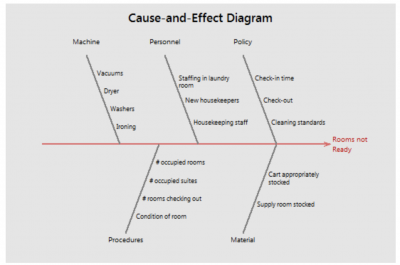
Key Points
- A cause-and-effect diagram is a visual tool for organizing possible causes of a problem.
- It allows users to determine if there are relationships between potential causes.
- It does not reveal the root cause, which will take further exploration for users to determine.
The effects and impacts of a problem or defect can often be clear to see, but understanding the potential causes can be tricky. Wouldn’t it be great if we had an intuitive, visual tool that helps us to capture potential causes and their relationship to the effect?
Welcome to the cause-and-effect diagram.
What Is a Cause-and-Effect Diagram?
A cause-and-effect diagram is a visual tool used to logically organize the many possible causes for a specific problem or effect by displaying them graphically. It is used successfully in continuous improvement activities across many industries and businesses.
The ability to visually represent many potential causes and explore causal relationships is a significant benefit of creating and using a cause-and-effect diagram. It is particularly helpful if there is little quantitative data available for analysis. However, care should always be taken with the use of qualitative data and hypotheses, ensuring that individual opinions do not bias the outcome.
Logical organization of the possible causes is a key part of creating a cause and effect diagram and these are often categorized with common headings such as Environment, Equipment, Methods, People, Materials, and Measurements.
An example of a cause-and-effect diagram is shown below:

Image source: support.minitab.com
A popular approach for creating a cause-and-effect diagram is:
- Assemble an enthusiastic team and agree on the scope of the task – what effect is to be investigated?
- Conduct brainstorming sessions to capture the many potential causes.
- Graphically represent the causes in a fishbone diagram or similar template.
- Agree what measurements or analyses are required to explore the causes and their quantitative relationships to the effect.
It’s important to remember that the cause-and-effect diagram does not yield the root cause. It also doesn’t account for the sensitivity of effects to the cause.
Is It Just an Ishikawa Diagram?
To put it succinctly, yes, a cause-and-effect diagram is just an Ishikawa or Fishbone Diagram. You’ll know this tool if you have any familiarity with the 7 QC tools found in Six Sigma. What makes the Ishikawa Diagram so useful is how it drills down to the issues you’re facing immediately.
An Industry Example of a Cause-and-Effect Diagram

A healthcare department conducted an internal audit and patient satisfaction survey to better understand department throughput and capacity constraints. The audit and survey highlighted that long waiting times for the patient when in the department were a key issue.
The department quality leader was experienced in cause-and-effect determination techniques. They decided to explore the causes of long waiting times by using a cause-and-effect diagram.
A small team from the department was asked to contribute to the cause-and-effect analysis. They took part in three brainstorming sessions including training on the methods of constructing the diagram.
The primary effect to be explored was agreed as long waiting times. The effects were classified into four main categories: Environment, Equipment, People, and Methods. In total, 21 potential causes were identified for review. The cause and effect diagram was displayed clearly in the quality and administration offices for three months. Potential causes were explored and metrics were defined for acceptable waiting times.
After another six months, a follow-up audit and patient satisfaction survey were conducted to provide quantitative and qualitative data to improve patient waiting times.
Other Useful Tools and Concepts
Looking for other tools to bolster your organization? You might want to look into X-bar and R charts. These control charts are useful for determining whether or not your processes are undergoing any special cause variation or are functioning as expected.
Further, understanding how to reduce defects in your production leads to greater customer satisfaction. Thankfully, there are quite a few tools at your disposal when it comes to eliminating defects. Our guide on the subject offers a comprehensive view of what you can use to streamline your production.